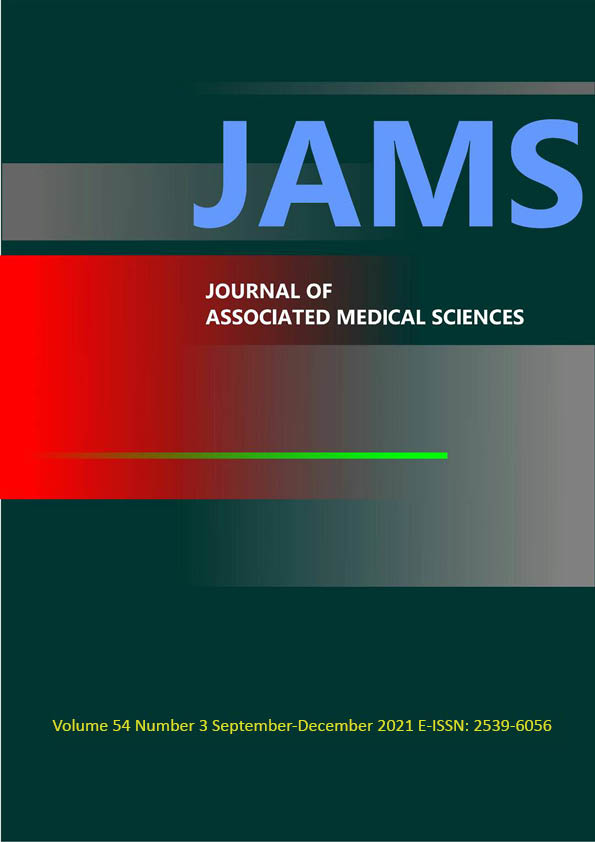Calculation of absorbed doses from computed tomography in pelvic phantom using Monte Carlo Simulation
Main Article Content
Abstract
Background: Computed Tomography (CT) is an effective diagnosis method which deposits high absorbed doses on internal organs; therefore, it is necessary to understand dosimetry nature of this method.
Objectives: To improve CT absorbed dose estimation by using a more appropriate phantom representing a human body and a Monte Carlo transport code.
Materials and methods: The Monte Carlo N-Particle transport code Version 5 or MCNP5 is used in this study to simulate a Rando phantom representing pelvic section of a patient in a CT procedure. Absorbed doses of various internal organs from MCNP5 are compared with standard experimental measurements based on the InLight nanoDot dosimeters.
Results: CT absorbed dose between MCNP5 simulation and standard experiment measurement are mostly in reasonable agreements within 10-percent discrepancy except those at skin positions.
Conclusion: Further study is recommended for calculating absorbed doses at skin positions, MCNP5 is practically reliable for estimating absorbed doses in a number of internal organs. The MCNP5 simulation is one of alternative method to evaluate patient radiation dose which helps radiology team manage diagnosis and treatment planning.
Article Details

This work is licensed under a Creative Commons Attribution-NonCommercial-NoDerivatives 4.0 International License.
Personal views expressed by the contributors in their articles are not necessarily those of the Journal of Associated Medical Sciences, Faculty of Associated Medical Sciences, Chiang Mai University.
References
McNitt-Gray MF. AAPM/RSNA Physics Tutorial for Residents: Topics in CT. Radiation dose in CT. Radiographics. 2002; 22(6): 1541-53.
Moore BM, Brady SL, Mirro AE, Kaufman RA. Size-specific dose estimate (SSDE) provides a simple method to calculate organ dose for pediatric CT examinations. Medical physics. 2014; 41(7): 071917.
Jarry G, DeMarco JJ, Beifuss U, Cagnon CH, McNitt-Gray MF. A Monte Carlo-based method to estimate radiation dose from spiral CT: from phantom testing to patient-specific models. Physics in Medicine and Biology. 2003; 48(16): 2645-63.
Booth TE, Hughes HG, Zukaitis A, Brown FB, Mosteller RD, Boggs M, et al. Estimated Relative Errors in MCNP. In: Girard SM, editor. MCNP — A General Monte Carlo N-Particle Transport Code, Version 5 Volume I: Overview and Theory. 1. CA, USA: Los Alamos National Laboratory, 2003. p. 113-5.
Griglock TM, Sinclair L, Mench A, Cormack B, Bidari S, Rill L, et al. Determining Organ Doses from CT with Direct Measurements in Postmortem Subjects: Part 1—Methodology and Validation. 2015; 277(2): 463-70.
Kara U, Tekin HO. Estımatıon of Absorbed Dose Dıstrıbutıon in Dıfferent Organs durıng the CT Scan: Monte Carlo Study. Austin Journal of Radiology. 2017; 4(1): 1063.
Okazaki T, Hayashi H, Takegami K, Okino H, Kimoto N, Maehata I, et al. Fundamental Study of nanoDot OSL Dosimeters for Entrance Skin Dose Measurement in Diagnostic X-ray Examinations. J Radiat Prot Res. 2016; 41(3): 229-36.
Takegami K, Hayashi H, Yamada K, Mihara Y, Kimoto N, Kanazawa Y, et al. Entrance surface dose measurements using a small OSL dosimeter with a computed tomography scanner having 320 rows of detectors. Radiol Phys Technol. 2017; 10(1): 49-59.
Thomas MG, Lindsay S, Anna M, Brian C, Sharatchandra B, Lynn R, et al. Determining organ doses from CT with direct measurements in postmortem subjects. Radiology. 2015; 277: 463-70.
Kara U, Tekin H. Estimation of absorbed dose distribution in different organs during the CT scan: Monte Carlo study. Austin J Radiol. 2017; 4: 01-3.


